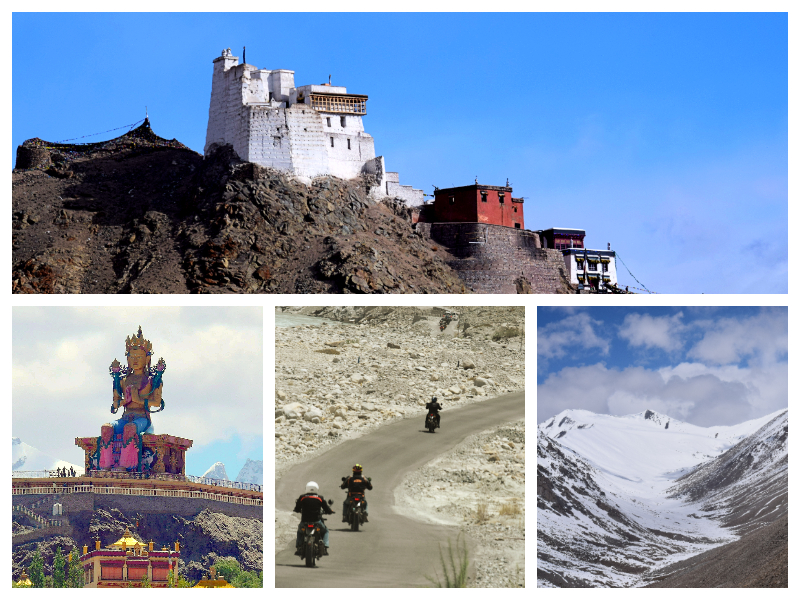Ladakh, the Land of High Passes is not just another travel destination but it is an experience of a lifetime. With an extremely high altitude and low oxygen levels, most places in Ladakh pose challenges even to the fittest and able-bodied individuals. Hence to make the trip memorable and stress-free, it is important to spend some effort in the planning and preparation. If you intend to travel to Ladakh, then here are a few tips to help you in your planning.
When to visit
- The tourist season runs from May to September, with June being one of the busiest months when tourists from all over the world visit Ladakh.
- July and August are the monsoon months with chances of landslides and sudden cloud bursts.
- September and October also witness considerable tourist footfalls as the chill gradually sets in the region.
- November to February is the winter season with temperatures dipping drastically and most of the routes remain closed due to heavy snowfall.
- March and April are the months when the snow layer starts melting. The BRO and other agencies mostly undertake snow clearance operations along the major routes to ensure the smooth movement of the military, civilian, and tourist vehicles.
How to get there
By Road
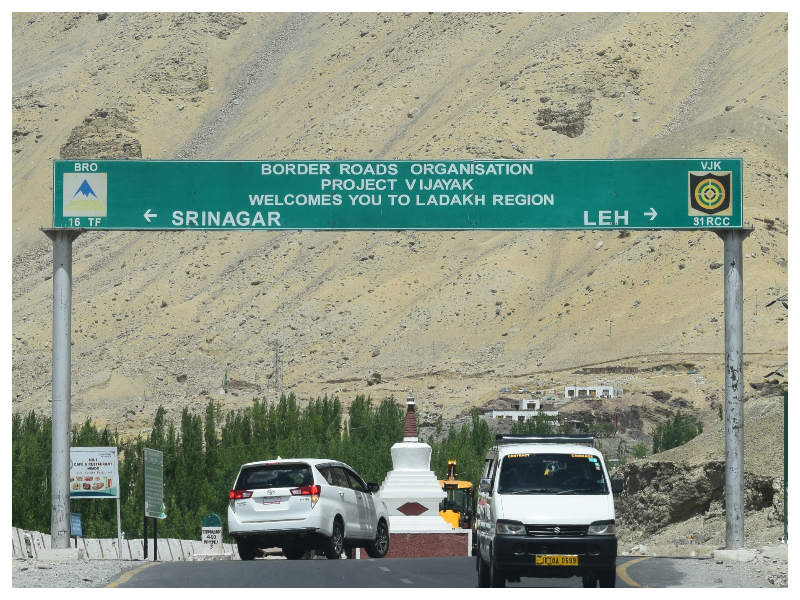
The road route into Ladakh comprises two stretches namely the Srinagar – Leh national highway and the Manali – Leh road.
- The 434 km Srinagar to Leh highway crosses the Zoji La, Namika La, and the Fatu La passes.
- The 475 km Manali to Leh road is a more scenic one and passes through the Rohtang pass.
By Flight
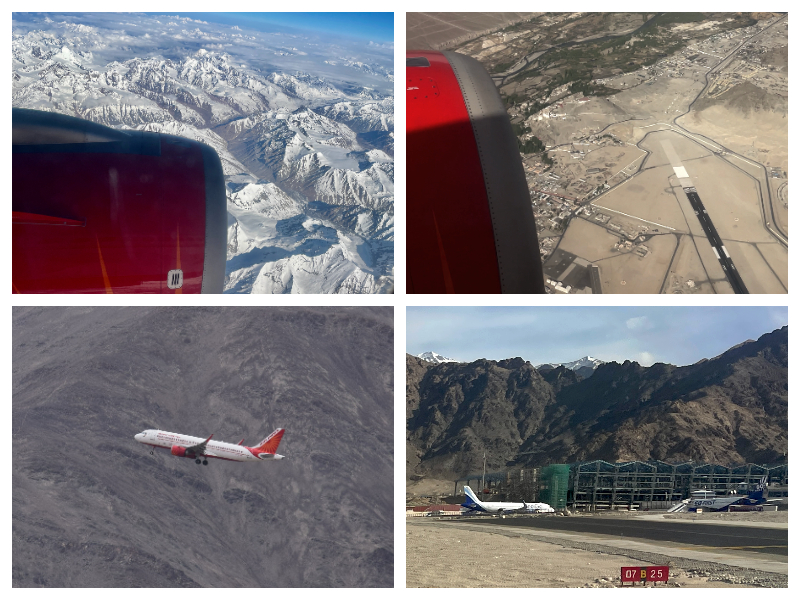
Travel by road helps the tourists to acclimatize and adapt faster to the environment of the region. However, most of the visitors prefer flying into Ladakh even though it gives less opportunity for acclimatization.
- Kushok Bakula Rimpochee Airport in Leh is the main airport in Ladakh and it is well connected to the national capital Delhi.
By Train
Ladakh doesn’t have train connectivity. The nearest railway station is Jammu Tawi around 650 km from Leh.
Where to stay
Tourists will find a lot of options for accommodation in Ladakh. One can choose from a wide category of hotels, inns, lodges, hostels, resorts and camps based on the preference for convenience, comfort and budget.
Accommodation in Leh
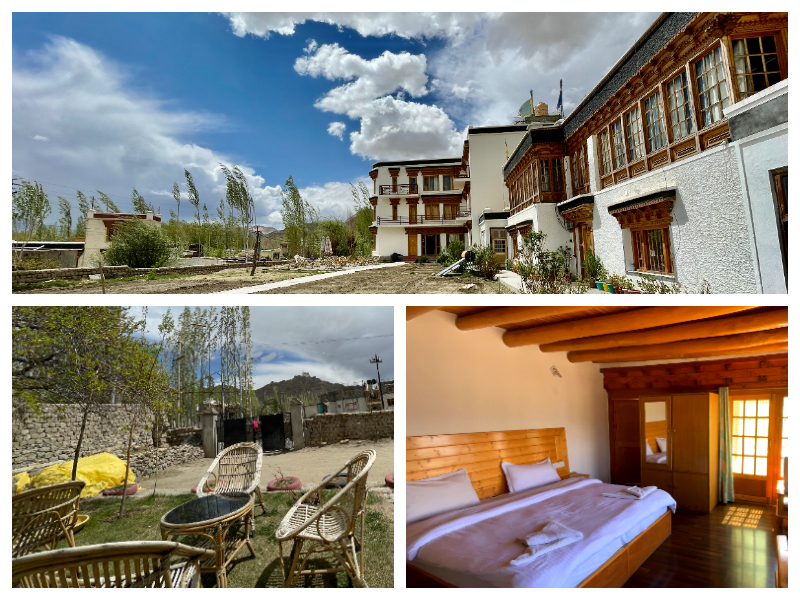
- Hotels – Tourists can choose from a wide range of Standard, Delux, or Premium hotels in Leh as per their preference. The reservations for these hotels can be done online or through travel agents.
- Homestays – Those looking for a peaceful, tranquil, and eco-friendly experience can opt for homestays. Ladakhi families usually run such properties. Food options may be limited in the homestays. The meals are mostly prepared from the fruits and vegetables grown in the organic gardens within the premises.
- Youth Hostels – Youth hostels are ideal for solo travelers or those traveling on a shoestring budget. Such hostels will usually provide accommodation in large dormitories or private rooms with shared bathrooms.
- Boutique Resorts – Those looking to splurge on stay can consider the boutique resorts. One option is the Stok Palace Heritage Hotel. It is a 200-year-old historic property that is open to tourists.
- Camps – Tourists can also opt to stay in camps. Most of these camps are located close to the Indus river area away from the city center. The camp sites are aimed at promoting ecologically sustainable tourism like using solar panels for electricity, recycling wastes etc. Tourists at the campsites can enjoy some stunning views of snow-capped mountains with the rivers/streams flowing between them.
Accommodation in Nubra
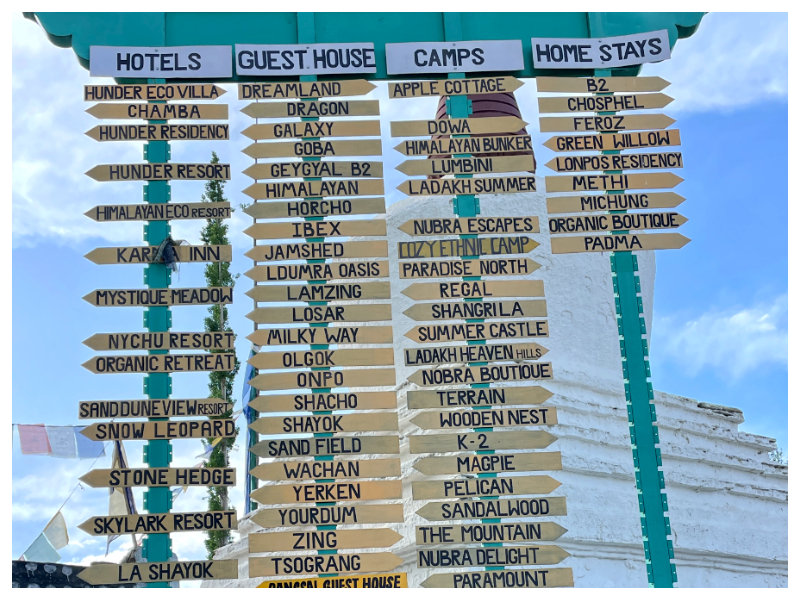
- Diskit being the district headquarters, has a large number of hotels, homestays, and guesthouses.
- Hunder which is around 10 km from Diskit also has a lot of options for accommodation. It is mainly famous for the sand dunes and the Bactrian/double hump camels.
Accommodation in Pangong
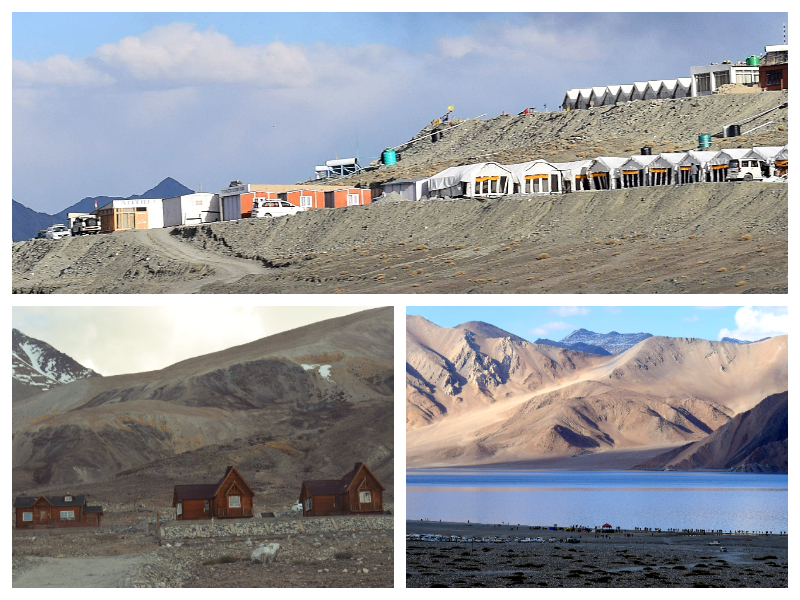
Pangong is one of the most remote places in the Ladakh region. Hence the options for accommodation include camps, tents and guesthouses only. Luxury hotels are not available in this area. Spangmik, Man, and Merak are small settlement areas along the bank of the Pangong lake where most of the tourist campsites are located. Most of these sites offer rooms with attached toilets. Electricity is usually provided through generators and is available only for a few hours in the evening.
What to carry
Clothes
Ladakh is prone to frequent temperature variations throughout the day. Hence it is advisable to wear multi-layered clothing. With such clothing, the tourists can put on more clothes when there is a dip in temperature or can opt to remove some when the temperature rises.
- A good quality thermal wear (complete set) should serve as the first layer. For a week-long trip, tourists should carry at least 2 sets of thermals.
- The second layer should comprise of regular full sleeves Shirt / T-Shirt and Jeans/Cargo pants.
- The third layer should be a woolen top/sweater or a hoodie.
- The fourth layer in form of a down jacket may come in handy in places where the temperature drops drastically like at the high altitude passes or in the areas near the lakes which remain windy, especially in the evenings. Tourists planning to travel to Ladakh during the summer season should consider jackets suitable for temperatures from 0 degrees to 5 degrees. Decathalon stores have a very good variety of jackets for different temperature ranges. Tourists can check out the jackets in the stores or on the online Decathalon site.
- Apart from the above, one should also carry woolen gloves, balaclava or monkey caps to protect from harsh winds and low temperatures.
Footwear
Flimsy, loose-fitting, and high heel footwear are not suitable for Ladakh. A decent pair of sneakers (waterproof preferably), boots and a strong pair of slippers are a must-have for the Ladakh trip. Apart from that tourists should also take along a few pairs of woolen socks.
Medicines
Medicines are one of the bare necessities for Ladakh trip. Hence one must carry a kit of essential medicines as a first aid. Here is a list of medicines that the tourists should consider taking along with them:
- Paracetamol to treat aches and pain.
- Pain relief spray/balm.
- Throat lozenges for sore throat. Betadine gargle solution is an effective treatment for sore throat.
- Dispirin for headaches.
- Medicines for acidity, vomiting, and diarrhea
- Sunscreen with SPF 50 – The Sun in Ladakh is extremely harsh and without an appropriate sunscreen lotion/cream, there is a high risk of getting sunburns.
- Antiseptic lotion, bandages, cotton, and ointments for wounds and cuts.
- Generally, tourists take Diamox to avoid Acute Mountain Sickness. Click here to know more about Acute Mountain Sickness (AMS). But before taking it, due consultation should be done with a registered medical practitioner.
- Sachets of ORS (Oral Rehydration Solution) for treating dehydration.
- Portable Oxygen cans as first aid for any kind of breathing difficulty. Such cans are readily available in chemist shops in the city of Leh.
- Tiger Balm (White) for motion sickness.
- A pulse oximeter to check the SPO2 levels.
- Any kind of personal medication for pre-existing diseases as prescribed by the doctor.
Important: Always seek the guidance of your doctor before taking any of the medicines/products mentioned in the list above especially if you have any pre-existing medical condition or allergic to the contents/ingredients.
How to get around
Public Bus Service
Leh being the main city in the Ladakh region, it has public bus service to other tourist areas like Diskit, Sumur, Pangong Tso, and Turtuk. However, the frequency of the bus service is erratic. The bus to Nubra valley region runs every alternate day from Leh and the bus to Pangong Tso runs twice a week. There is no online seat reservation facility for the buses. Tourists may not find the public bus service to be convenient for exploring Ladakh.
Shared Taxis
There are shared taxis option too which are more suited for solo travelers. Ads for shared taxis can be found online. Leh-Ladakh-Taxi is one such site where tourists post advertisements for travel companions / buddies. Even the cafes and restaurants in Leh put up a lot of advertisements and flyers inviting travelers for shared trips within various places in Ladakh.
Private Taxis
Private Taxis are the most convenient mode to explore Ladakh especially for large group of tourists travelling together. Tourists can book these taxis for local sightseeing as well as outstation trips.
Please note, that non-local taxis (i.e taxis coming from other states) are allowed only till Leh. Tourists are not allowed to travel beyond Leh in non-local taxis.
Self-Drive Rentals
Rental Self Drive Cars are not allowed in the entire Ladakh region.
Self-Owned/Personal Vehicle
There is no restriction on taking self-owned/personal vehicle for exploring the places within Ladakh. But the terrain being mountainous as well as the roads in some areas being in extremely bad shape, sufficient care must be taken while driving the vehicles. A car with good ground clearance is ideal for the Ladakh trip.
Bike Rentals
Tourists can also opt for Bike Rentals. Many agencies in Leh offer various kinds of bikes for both local sightseeing as well as outstation trips. The rate is usually fixed for renting the bikes and one needs to have a valid driving license to take a bike for rent. Essential driving gears like Jackets, Kneecaps, Elbow caps, etc are not available for rent. The tourists need to purchase these separately from the market if they are not carrying them already.
Important things to keep in mind
Phone Connectivity
One of the most important things to keep in mind is that Prepaid SIM cards don’t work in the entire Ladakh region. Hence tourists should carry post-paid SIMs. The other option is to get a Prepaid SIM from the Leh market after reaching there. JIO, Airtel, and BSNL have good coverage in Leh and Nubra valley region. But in remote areas like Pangong Tso, only BSNL coverage is available.
Internet Connectivity
Most of the Hotels, Homestays, and Lodges in Leh and Nubra region provide Wi-Fi connections within their premises. However, the speed often fluctuates. The mobile network is also not very stable in the region and the connection keeps switching between 3G/4G. Some areas may not have mobile internet coverage at all.
Cashless Payment and ATMs
Most of the shops in Leh and Nubra valley region accept cashless payment through GPay, PayTM, etc, or payment through cards.
Cash is usually needed in shops in remote areas and also at the ticket counters at the various sightseeing places.
For the Ladakh trip, one should keep sufficient cash if traveling to the remote areas as finding ATMs might be difficult outside the Leh city limits. Tourists can consider waist pouches or travel money bags for keeping cash. Such bags can be worn inside the inner layers of clothes and is a safe way of storing cash as well as important documents during a trip. These are readily available in the Decathalon stores and on the major online shopping sites.
Public Toilets
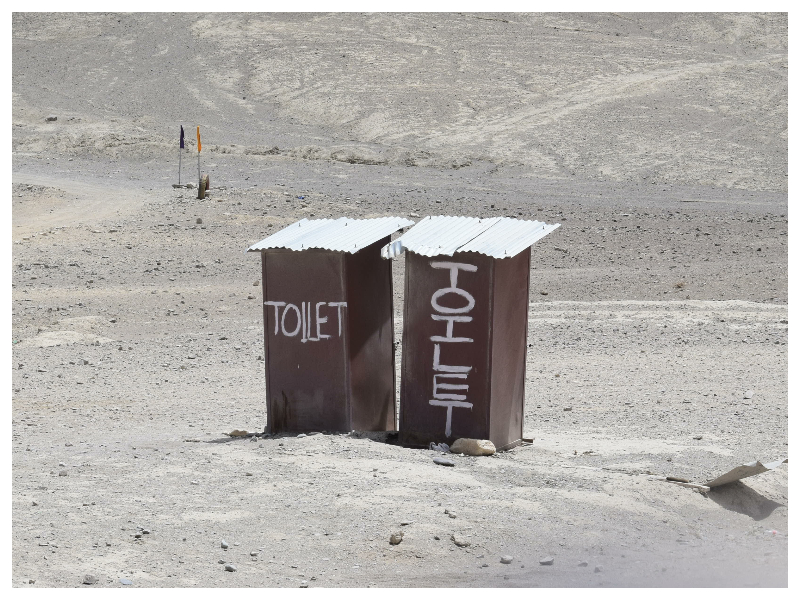
Leh city has quite a few public toilets especially in the market area as well as near the major tourist spots. Needless to say, the paid toilets are much cleaner and better managed than the free ones. Outside Leh, finding public toilets is a bit difficult. The restaurants and eateries along the tourist routes in Ladakh have toilets but these are mostly in bad shape and unclean. Also, the terrain in Ladakh is barren and devoid of any trees or bushes. So answering nature calls in open may not be a good idea.
If you feel an urgent need to pee in areas where there is no restroom available, then you can consider using Travel Loo Disposable Urinal. This product is unisex and safe to use. It is very convenient for hiking, camping, or long road trips. One can get this product on the popular online shopping portals.
Female tourists can look at using Female Urination Devices in the public toilets to avoid UTIs and toilet germs. PeeBuddy is a popular brand that manufactures such devices. These are readily available on most online shopping portals.
Documents to carry
- Indian nationals should carry original Photo IDs as well as Address proof documents. Also, keep some photocopies of the same. You may share the soft copies of your Photo ID documents with your travel agent/driver in advance so that they can arrange the required passes/permits. These documents are needed at the checkpoints like South Pullu en route to Khardung-la Pass.
- Foreign nationals, persons of Indian Origin, and Non-Resident Indians will require a Protected Area Permit (PAP) issued by the Government of India for traveling to the restricted areas in Ladakh.
- Keep a copy of the medical insurance if availed.
- Note down the phone numbers of some of your relatives and friends in a paper and keep it for the entire duration of the journey. This might come in handy in case of emergencies especially when the phone batteries are low or dead.
Medical centers in Ladakh
There are various small and large medical centers in Leh as well as other regions within Ladakh. Also, the Indian Army has set up various dispensaries in many areas in Ladakh to help tourists in case of emergencies. Here is a list of medical centers along the major tourist routes in Ladakh:
- Sonam Norboo Memorial Hospital in Leh. It is a fully equipped medical center with modern sophisticated equipment. It has a bed strength of 150.
- Army’s General Hospital in Leh.
- Indian Army medical camp in South Pullu. It provides basic medical services like SPO2 check and first aid.
- Indian Army medical camp at Khardung La top. This camp also provides basic medical services.
- Sub-District Hospital in Diskit (in Nubra Valley). It has a bed strength of 50.
- Primary Health Centre Turtuk.
- Primary Health Centre Tangste (35 km from Pangong Tso).
- Indian Army medical camp at Chang La top. It provides basic medical services.
Acute Mountain Sickness (AMS)
Acute Mountain Sickness or AMS is a high-altitude ailment. This mostly impacts people when they travel to the high altitude places too quickly. Under such circumstances, the symptoms of AMS appear as the human body tries to adjust to the lower air pressure and low levels of oxygen. It can affect anyone irrespective of their physical health condition and age.
In its mildest form, AMS causes a headache, shortness of breath, dizziness, nausea, and muscle aches. Severe symptoms of AMS include chest congestion, blood in vomit, severe coughing, pale skin, and inability to walk or keep the balance while walking.
Tips to prevent AMS
Most of the tourists in Ladakh face milder symptoms of AMS. Severe cases of AMS can be avoided if certain tips are followed:
- First and foremost, even before undertaking the trip to Ladakh, one should slowly start indulging in daily physical activities like walking or jogging. This will improve physical endurance, especially for those who follow a sedentary lifestyle.
- One should also start practicing breathing exercises before traveling to Ladakh. The oxygen levels being low there, such breathing exercises will help in a major way to increase its level in the blood instantly and naturally. Pursed Lip Breathing and Belly Breathing exercises are a few techniques that can help in addressing oxygenation, shortness of breath, and chest tightness issues.
- Once tourists reach Leh, they should acclimatize themselves for at least 2 days. This is important, especially for those who choose to fly into Leh. As part of the acclimatization process, one should
– Take proper rest in Leh without any kind of physical exertion for the first 2 days. – Keep your body hydrated with ORS, juices, or plain water.
– Avoid taking too much tea, coffee, or caffeinated drinks.
– Stay away from alcohol as it can be dehydrating.
– One shouldn’t smoke as it can make breathing heavier.
– After reaching Leh, refrain from taking bath on the first day as taking bath will reduce body temperature and slow down the acclimatization process.
– Keep body warm
– Eat light but a high-calorific value diet. Avoid heavy, deep-fried, oily, and fatty food.
- As per the locals, inhaling camphor during ascend to higher altitude places like Khardung La or Chang La will help in preventing AMS. But inhaling camphor directly might sometimes lead to poisoning, especially in children. Therefore, due care must be taken while inhaling it.
- A good alternative to inhaling camphor is applying Tiger Balm(White) on the nostrils. It is a very good remedy for travel sickness. It has camphor and menthol as active ingredients. And it eases breathing and gives relief from headaches and nausea.
- If Khardung La and Chang La are on the itinerary, then don’t stay at these places for more than 10 mins. Staying for a long duration at these places can trigger headache and dizziness.
- One may take Diamox tablets to prevent AMS but only after due consultation with a doctor.
Tips to treat AMS
If due care is taken and steps for acclimatization are followed properly, then severe forms of AMS can be avoided. However, in rare cases, AMS may become severe and will need immediate / emergency care. In critical cases, AMS impacts the brain as well as the lungs and can be life-threatening.
- HACE or High altitude cerebral edema is a condition in which there is swelling of the brain due to the lack of oxygen. Symptoms of HACE include extreme headache, dizziness, loss of coordination, confusion, and hallucinations. It can develop quickly and can be fatal.
- HAPE or High altitude pulmonary edema is a condition in which there is fluid build-up in the lungs. Symptoms of HAPE include extreme coughing, blood in the cough, pale skin, breathing difficulties, and tightness in the chest.
The treatment for severe forms of AMS includes:
- Descending to a lower altitude area immediately.
- Getting supplemental oxygen. Portable oxygen cans may not be helpful in this case. A proper oxygen cylinder or tank may be needed. You may refer to the section “Supplemental Oxygen” below for details.
- There are certain steroids and medicines for treating HACE and HAPE. These should be taken only after due consultation with a doctor or health care provider.
- Seek emergency medical care without any delay.
Though supplemental oxygen is usually not needed for Ladakh trip, there is no harm in carrying it as a first aid. The SPO2 or blood oxygen levels in Ladakh usually fluctuates between 80 to 85 percent. If you are traveling in a large group and have kids or elderly people with you then carrying an oxygen can or cylinder is advisable. Most of the places in Ladakh are remote areas where getting immediate medical assistance for breathing problems may be difficult. In such cases, supplemental oxygen can be given as first aid for altitude related sickness. Tourists can consider the following options for carrying oxygen:
- Portable oxygen cans – One can get the portable oxygen cans easily from chemist shops in Leh. Such cans generally provide 150 to 200 puffs of oxygen each. These cost between INR 500 to 600 per can.
- Oxygen cylinders – These are bigger and one can take them on rent from Oxygen bars in Leh. Alternatively, the travel agents can arrange these cylinders upon request. Based on the capacity of the cylinders, the number of days of the trip, and the time of the year, the charges are set. A smaller cylinder of 250 – 300 liters capacity may last for about 2 hours at a flow rate of 2 liter per minute and the cost may vary between INR 1500 to 2500 for the entire trip duration. Larger capacity tanks are also available for the tourists.
Please note, that airlines don’t allow portable oxygen cans or cylinders to be carried on the flight. Tourists can procure these from Leh.
- Tourists should be mindful of their attire in Ladakh. Avoid wearing revealing clothes.
- The locals in Ladakh are peace-loving, jovial, and warm people. Always greet them with a smile. “Julley” is the Ladakhi word for “Hello”. It is used frequently for greeting people in Ladakh.
- Avoid using plastic and polythene bags.
- Electricity supply in Ladakh is erratic and there are frequent power cuts. Always carry additional batteries and power banks to charge the phones and other devices.
- Download Google Maps for Ladakh region so that you can use it in offline mode even if there is no internet connectivity.
- Ladakh has very diverse flora and fauna. There are many animals like the Ladakhi Kiangs, the Himalayan Marmots, wild horses and the Bactrian camels which are endemic to the region. Don’t harm, feed or disturb the animals as it might impact their natural behaviour and the entire ecosystem.
Final Words
Ladakh is one of the top tourist destinations in India. The naturalistic wonders of the region attract thousands of tourists every year. Though problems related to rough terrain, unpredictable weather conditions, and high altitude exist in Ladakh, with proper precautions and planning one can definitely make the trip enjoyable.
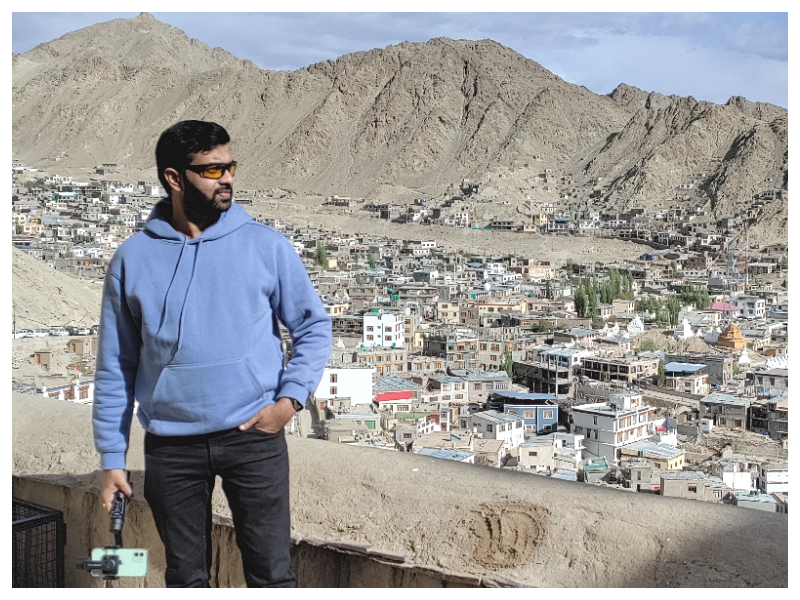
For more posts on travel, please visit our Wander Lust section.
For posts on gardening, please visit our Garden Venation section.
